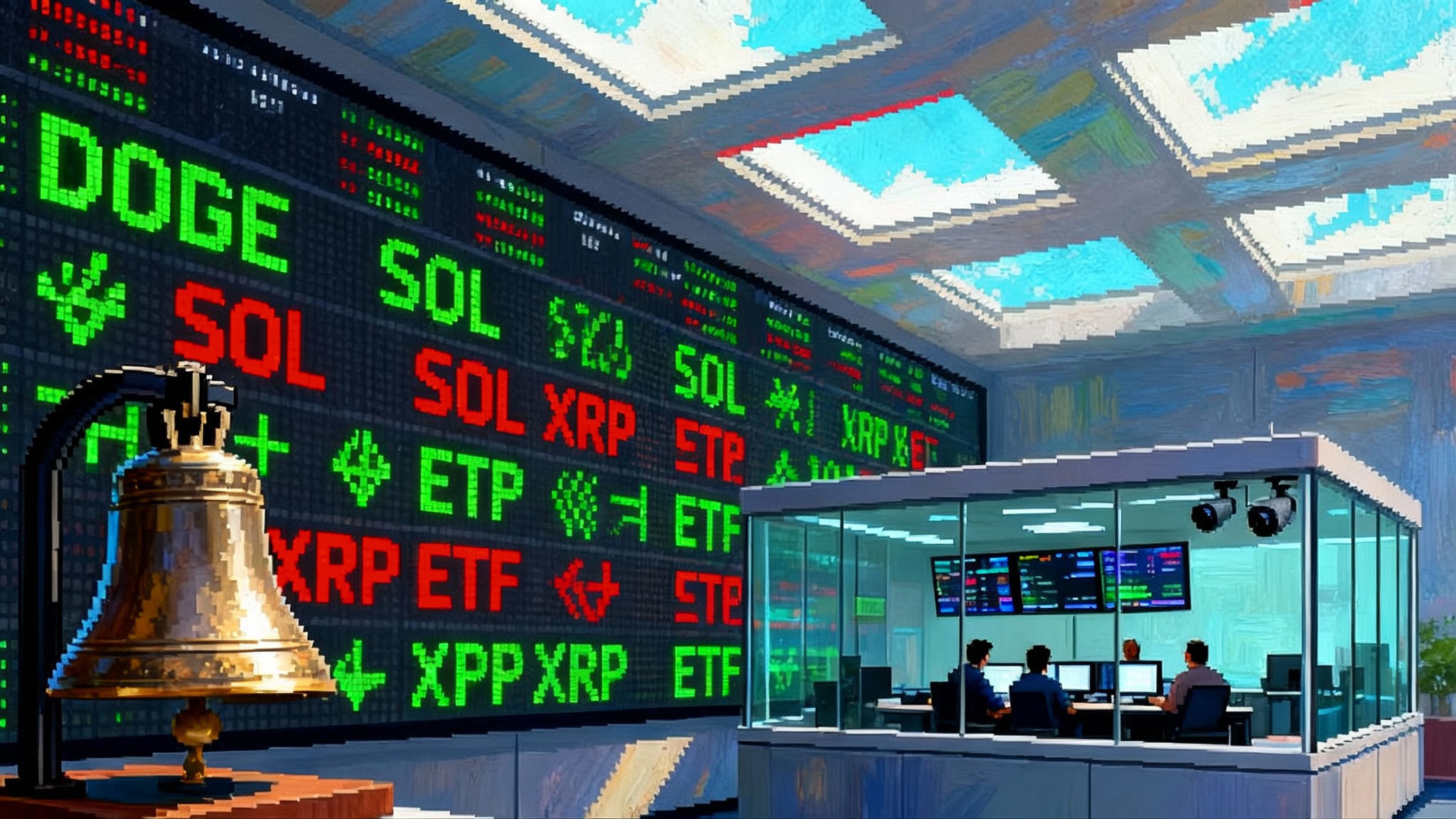SEC fast-tracks altcoin ETFs: Dogecoin’s debut and beyond
A September rule change lets U.S. exchanges use generic listing standards for spot digital-asset ETFs, shrinking approvals and opening the door beyond bitcoin and ether to Solana, XRP, and Dogecoin. Here is what changes next.

The rule that changes the game
On September 17, 2025, the Securities and Exchange Commission approved generic listing standards for commodity-based exchange traded products that hold spot assets, including digital assets. That single vote breaks the case-by-case logjam that kept every new spot crypto fund in a months-long approval cycle. With the new path, a qualifying fund can list if it fits the pre-set criteria the exchanges now maintain, rather than waiting for a bespoke Commission order. The policy shift is subtle in form and sweeping in effect, because it hands more responsibility to exchanges and makes crypto exposure feel like any other commodity ETP. The SEC’s announcement framed it as a modernization of process to widen investor choice while keeping the market’s guardrails in place via the Commission’s release.
Two things are worth noting up front. First, the SEC’s vote occurred on September 17, while most coverage hit on September 18. Second, this is not a blank check. Exchanges still must police listing eligibility, issuers still must register their securities, and anything outside the new standards still needs a formal filing. But for a large and growing set of spot crypto funds, the default setting switched from no to yes, and the clock moved much faster.
What “generic listing standards” actually do
For years, a spot crypto ETF or ETP needed two approvals: one for the fund’s registration and one for the exchange rule change that allowed trading. The second was the big bottleneck. Generic listing standards let an exchange list new products without filing a new rule change each time, so long as the product fits within a defined template that spells out custody, pricing, dissemination of information, and surveillance expectations.
Think of it as moving from custom-tailored suits to off-the-rack. Issuers must still pick the right size and meet the dress code. In practice, that means:
- The exchange must have surveillance and investigative tools to detect manipulation, plus information-sharing arrangements with relevant markets.
- The reference price must be transparent and robust, with clear calculation and dissemination policies.
- Custody needs to meet strict operational, security, and disclosure standards, typically with qualified custodians and detailed attestations.
- Issuers must keep websites updated with key portfolio and operational details within days of trading.
The new framework also acknowledges two paths that can coexist in crypto:
- Commodity-based trust shares registered under the Securities Act of 1933 that hold spot crypto directly, similar to the way gold and silver trusts hold bullion.
- Investment Company Act of 1940 ETFs that gain exposure using permitted structures. In some cases, the existence of a 40 Act fund with significant exposure to a given commodity can help clear the way for related products under the exchange’s generic template.
The pipeline opens beyond BTC and ETH
Until now, bitcoin and ether were the only spot crypto funds to vault the SEC’s hurdles at scale. With generic listing standards, the door opens wider for large-cap tokens where price discovery is deep and custody is feasible. Issuers have already lined up products tied to Solana and XRP, and a handful of other networks with substantial trading footprints. The path is not automatic for every token, but the default is no longer a multi-quarter slog. Timelines compress from a maximum of roughly 240 days to about 75 days for eligible products, according to contemporaneous reporting that accompanied the rule change noting the shortened window.
Expect three waves:
- Large-cap, high-visibility names with multiple market makers ready to quote tight spreads, custody solved, and clear reference pricing.
- Mid-cap networks with institutional-grade custodians but thinner depth. These may follow as issuers prove they can meet dissemination and surveillance requirements.
- Niche tokens. The standards do not prevent these forever, but exchanges will be cautious, and many will continue to sit outside the template until liquidity, custody, and governance mature.
How market structure shifts
The new rule is not only about faster filings. It changes the flow of capital and risk across the crypto stack.
From CEX to ETF rails
- U.S. retail and advisors will migrate incremental dollars from offshore and lightly regulated venues to brokerage accounts. That likely reduces marginal U.S. spot activity on smaller exchanges and concentrates price discovery in a mix of U.S.-listed ETPs and the largest global venues.
- Coinbase, Fidelity, and other qualified custodians may see inflows as ETP sponsors consolidate assets with a handful of sub-custodians that meet institutional security and audit requirements.
Surveillance and price formation
- Exchanges listing these funds must lean on information-sharing and surveillance technologies. That increases the cost of listing but should raise the bar against manipulation, wash trading, and spoofing in the reference markets they rely on.
- More transparent reference pricing and intraday indicative values can tighten tracking error. Over time, that pulls spot and ETF markets into a tighter arbitrage band, as happened with gold and silver.
Liquidity and volatility
- Creation and redemption give market makers a release valve. When funds trade at a premium, they can deliver in-kind or cash to create shares and sell them down. When discounts appear, they can redeem shares for the underlying. That helps dampen long squeezes and panic discounts.
- For altcoins with episodic liquidity, APs will demand wider spreads or risk premia during stressed hours. Expect occasional volatility around rebalances and large creations, especially in coins with thin weekend order books.
Options and basis markets
- Once spot ETPs list, options on those ETPs and their indexes tend to follow. That broadens the hedging toolkit for market makers and quant funds and can reduce realized volatility as more risks get laid off into listed options.
- The futures and basis markets will evolve. Some funds may use cash creations, which put pressure on spot sourcing, while others will prefer in-kind. The choice affects liquidity in the underlying and the behavior of basis during risk-on surges.
Investor protection tradeoffs
The SEC’s approach tries to balance access with safeguards. The benefits are real, and so are the new risks.
Benefits:
- Transparency. Daily holdings, audited custody, and on-exchange prints beat the opacity of many offshore venues.
- Lower friction. No wallets or private keys, less tax confusion, and clean 1099 reporting for many investors.
- Tighter spreads. Competition among issuers and market makers can push total cost of ownership down over time.
Risks and tradeoffs:
- Complexity creep. Once the generic door is open, issuers will test the edges. Not every token has robust markets, and some will struggle with tracking and fair value in stressed moments.
- Fee drag. Single-coin funds often charge higher expense ratios than broad index ETFs. Compounded over years, that can materially reduce returns versus holding tokens directly.
- Narrative risk. Packaging speculative assets in familiar wrappers can lull investors into underestimating volatility and drawdowns.
Winners and losers
Winners:
- Issuers with crypto DNA and ETF muscle. The firms that already built plumbing for bitcoin and ether have a head start. Expect them to capture first-wave listings in Solana, XRP, and the most liquid altcoins.
- U.S. exchanges. NYSE, Nasdaq, and Cboe now have a clearer, faster process. Listings and options ecosystems that spin up around these funds are new revenue lines.
- Qualified custodians. Coinbase Custody, Fidelity, and a short list of peers will consolidate assets as more issuers choose fewer, larger vaults.
- Market makers and APs with crypto chops. Those that can source inventory across on-chain, OTC, and exchange venues will earn spreads in creations, redemptions, and options.
- Large token communities with real depth. Networks with healthy spot volumes, active derivatives markets, and institutional-grade infrastructure will be first in line for low-fee, tight-spread products.
Potential losers:
- Smaller centralized exchanges. As U.S. capital migrates to brokerage accounts, CEXs that relied on retail flows and long-tail tokens may see volume stagnate.
- High-cost issuers. The fee war is coming. First movers can charge for a while, but as second and third entrants arrive, headline expense ratios fall.
- Thin-liquidity tokens. Listing in an ETF wrapper does not create depth where none exists. If spreads widen and tracking degrades, enthusiasm can fade fast.
Case study: Dogecoin’s ETF debut
The first memecoin ETF to trade in the United States is more than a curiosity. It is a live test of how far generic listing standards and investor demand can stretch. Dogecoin is a proof of work asset with no staking yield, a large community, and a price history defined by bursts of viral attention. Wrapping it in an ETF changes who participates and how.
What to watch in the first months:
- Primary market mechanics. If the fund uses cash creations, APs must source DOGE on exchanges, which can widen spreads during heavy inflows. In-kind creations reduce that stress but require more complex operational plumbing.
- Tracking and spreads. Expect tight spreads in calm markets and occasional blowouts around celebrity tweets or weekend liquidity gaps. The arb bands will widen if custody or reference pricing is fragmented across venues.
- Fee drag and behavior. Single-coin funds in new categories often start with higher fees. If the Dogecoin ETF charges in the neighborhood of 1 percent to 1.5 percent, the drag will be noticeable in sideways markets. It becomes a tax on diamond hands, and it rewards traders who time entries and exits.
- Retail risk management. The ETF wrapper removes wallet risk but not market risk. Issuers and brokers will need crisp disclosures, risk banners, and education. Expect suitability flags at some platforms and tighter margin policies than for large-cap equities.
Signals of durable demand:
- Options launch and open interest. If options list quickly and open interest builds, that suggests a healthy two-sided market and better tools for hedging.
- AP club size. More authorized participants usually means tighter spreads and better resilience in stress.
- Secondary market volume concentration. High turnover with low premiums or discounts is the sweet spot. If premiums persist, there is either a creation bottleneck or a structural mismatch in underlying liquidity.
What it means for memecoin investing:
- The ETF wrapper gives the Dogecoin community a regulated on-ramp that is easier to hold in retirement and advisory accounts. That can extend the asset’s investor base from traders to allocators who want a small satellite position for risk-on cycles.
- It also sets a ceiling on hype cycles. With APs arbitraging premiums, vertical moves should be less dramatic than the wildest historical episodes, although sharp swings will still be common.
Mapping capital rotation with the gold and silver playbook
There is a useful analog in the adoption curves of commodity ETPs. SPDR Gold Shares launched in November 2004 and was one of the fastest growing ETFs on record, crossing the 1 billion dollar asset mark within days and passing 50 billion dollars by 2010. Silver’s flagship trust followed in 2006 and built a deep ecosystem of arbitrage, options, and global cross listings over several years. Those histories show how quickly a simple, transparent commodity wrapper can pull in capital when the asset already has high awareness and a plausible macro story.
For crypto spot ETPs beyond bitcoin and ether, consider three scenarios over the next 12 to 24 months:
- Base case. A handful of large-cap single-coin funds gain traction. Solana and XRP products attract steady inflows from advisors and retail brokerage, while memecoin exposure settles into a niche. Aggregate altcoin ETP assets reach the high single digit billions. Spreads tighten as more APs join and options list across venues.
- Bull case. Risk appetite and macro conditions align with a strong crypto upcycle. Index-style funds and baskets launch under the generic template, and large allocators use them for 2 percent to 5 percent satellite sleeves. Aggregate altcoin ETP assets climb into the tens of billions. Liquidity shifts meaningfully from offshore venues to U.S. brokerages, and options volumes accelerate the flywheel.
- Bear case. A sharp drawdown hits before ETP plumbing matures. Thin-liquidity tokens suffer tracking noise, spreads widen, and a few products pause creations during stress. Regulators revisit eligibility thresholds. The category resets with tougher standards and slower issuer pipelines.
The constant in all three paths is that a regulated, generic path to listing tends to grow the pie over time. Gold’s story was not linear, and neither will altcoin ETPs be. What matters is that investors can now express the view inside the market’s core plumbing, with better transparency, better hedging, and clearer rules of the road.
What to do now if you allocate capital
- Read the prospectus, then look at the exchange’s product page for surveillance and reference pricing details. The disclosures will tell you whether creations are cash or in-kind and how NAV is calculated.
- Compare total cost. Expense ratio is the headline, but creation fees, custody arrangements, and expected spreads matter. Early assets can be expensive until competition arrives.
- Size it like a satellite. Treat single-coin funds as tactical or satellite exposures. Rebalance rules matter more than narratives.
- Plan for stress. If you cannot tolerate a 50 percent drawdown in a single-coin position, you should rethink the sleeve size or stick to diversified baskets.
The bottom line
The SEC’s generic listing standards flip crypto ETPs from bespoke exceptions to a rules-based default. That compresses timelines, hands more responsibility to exchanges, and clears a path for altcoin exposure in mainstream portfolios. It also raises the bar for issuers and market makers who now must operationalize liquidity, surveillance, and custody at scale. Dogecoin’s ETF debut is not just a meme event. It is a stress test for how far investor protection and product design can stretch in a rules-based regime. If gold and silver are a guide, the pie is likely to grow, the winners will drive costs down, and the market will learn fast where the edges are.


